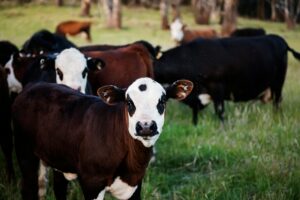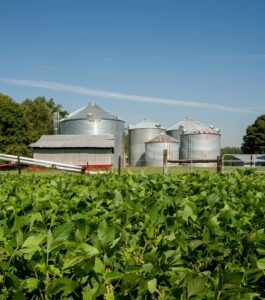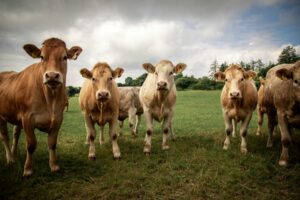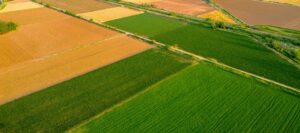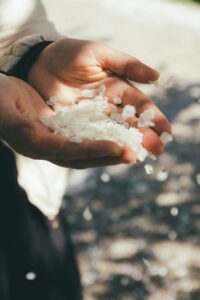Introduction
The different grades of wool mean it has many uses, from the very soft fibres that can be worn against the skin, to the coarse fibres with uses like insulation and stuffing.
Around 80% of wool is used to make garment products (sweaters, clothes, coats, hats), blankets and carpets. Wool is also highly flame resistant and so is frequently used for mattress and rug manufacturing. Other products include water proofing outer garments and sound proofing applications, Musicians might be interested to know that the piano’s distinct sound (compared to a harpsichord, for example) is a result of wool. The wool fibre is used to muffle the impact of the hammers on the strings.
Products made from wool are durable, flexible and can keep their appearance for a longer period than other fabrics.
- Fine wools (<19,5µ) are used in luxury products. Prices are rather volatile and poor quality (e.g. as a result of drought) suffers significant penalties on price. Fashion trends and consumer demand for soft, light products for next to the skin wear are and will remain the key drivers in this segment. The finer end of this segment competes with other products e.g. cashmere.
- Medium wools are usually in the 20-25µ category and are used essentially in the classical menswear, womenswear and knitwear product sectors. Probably the major offtake of wool in this product sector is in blends with synthetic fibres to target lower price points at retail, and in some cases to achieve certain technical effects. Prices in this category are particularly sensitive to competition from synthetics.
- Strong (coarse) wools (>26µ) are mainly used for interior textiles such as furnishings, carpets and bedding products.
Sources: Cape Wools SA; Wool Market Value Chain Profile; DALRRD-NAMC International TradeProbe, Issue No 55.
International business environment
Find updates on www.capewools.co.za.
- The global price for apparel wool is determined in Australia, the world’s largest supplier of apparel wool, where the largest volumes of wool are traded. South Africa, with its small clip, is therefore a market follower or price taker.
- Top wool producing countries are Australia, China, USA, New Zealand and Argentina. Turkey, Iran, UK, India, Sudan and South Africa follow.
- South Africa is a full member of the International Wool Textile Organisation (IWTO). Visit the IWTO website – www.iwto.org. Find global information and statistics on the website.
South Africa: imports and exports
- More than 90% of the wool produced in South Africa is exported.
- Wool accounts for about 2% of South Africa’s agricultural exports (Sihlobo, 2024).
- In 2023, South Africa exported 49 715 tonnes of wool (Sihlobo, 2024).
- Strong demand for natural fibre in the apparel industry faces off against challenges like any outbreak of foot-and-mouth disease (FMD) which results in losing export markets (2019, 2022); and trade logistical issues (BFAP, 2023).
- China represents the biggest market for South African wool exports. After Australia, South Africa is the second largest exporter into China.
- Other markets for the South African wool industry are the Czech Republic, Italy, India, Bulgaria, Germany, the United States, Japan and Mexico.
- The Cape Wools SA Annual Report gives information on export destinations for South African wool, and discusses issues arising around these exports.
Source: Sihlobo W. 2024 Agricultural Trade Digest 10 April; Sihlobo Agbiz blog, 2024, April 08; Sihlobo W. 2022, July 14 (see "Websites & publications" heading); Bureau for Food and Agricultural Policy (BFAP) Baselines 2023-2032,2021-2030, 2020-2029.
Local business environment
The Cape Wools SA Annual Report sets out the local business environment. The organisation supplies an SMS message service supplying market information directly after sales, as well as a weekly market report via e-mail. This information can also be found on its website, www.capewools.co.za.
The sheep and wool industry is one of the oldest agricultural industries in South Africa. As a largely export commodity it plays an important economic role as an earner of foreign exchange for the country.
Prior to 1994, the Cape Province was the most important wool producing area in Southern Africa. “Cape Wool” became the international generic trade term for all wool produced on the sub-continent. Today, the main production areas are in the Eastern Cape and Free State. Other high producing provinces are the Western Cape, Northern Cape, Mpumalanga and KwaZulu-Natal. Find the latest production statistics on www.capewools.co.za which sets out wool production per province and magisterial district.
Some 13.5 million sheep are farmed for their wool in South Africa, with emerging- and communal farmers accounting for 2 million of these. There are 8 000 commercial producers and some 45 000 emerging- and communal ones. Some 35 000 farm workers and 4 000 sheep shearers and wool handlers are employed by this industry, an important one for the stability of rural areas and the rural economy (NWGA, 2025).
The main sheep breeds used for wool production are the pure-bred Merino followed by other dual-purpose Merino strains (Dohne Merino, South African Mutton Merino and the Letelle). Merino farmers earn about two-thirds of their income from meat, but a high wool price improves their profitability.
Cape wools are traded either through the auction system or by private treaty. The largest percentage of the clip is sold through the auction system. Auctions have been centralised in Port Elizabeth and take place once a week during the season (August to June). Even though centrally auctioned, wools are warehoused in three of the four ports: Port Elizabeth, Cape Town and Durban.
Prices paid for Cape wools are determined by free market supply and demand forces and are closely linked to the international price for apparel wool, which is determined by the Australian market.
Most of the clip is marketed overseas through members of SAWAMBA. Only registered members of that organisation are allowed to bid at auctions held under the auspices of the South African Wool Exchange.
Source: Cape Wools marketing brochure available on www.capewools.co.za ; https://nwga.co.za/about/; and the Wool Market Value Chain Profile.
Small-scale farmer news
- Around half of the sheep in the Eastern Cape have always come from the former homeland (communal) regions. Unfortunately, people in these areas received very little for their wool. The National Wool Growers Association (NWGA) Woolled Sheep Development Programme aims to ensure sustainable economic wool sheep farming. Within the communal sector, the NWGA focuses on: (1) Infrastructure (2) Training and Mentorship (3) Genetic Improvement of flocks (4) Marketing support (5) Resource management.
- As a result, poor farmers in communal areas have been producing a high value commodity for the export market. Between 2000 and 2019 wool production by communal farmers has increased by more than 995%, reaching a high of 6,24 million kilograms in 2017 (BFAP, 2021).
- BFAP has estimated that with additional interventions and expansion of current programmes wool production by communal and small-scale farmers can increase to reach 9.48 million kilograms in 2030, with a total estimated value of R1.65 billion per annum (BFAP, 2021).
National strategy and government contact
Natural fibres like wool feed into the clothing, textile, footwear and leather (CTFL) subsector. The Retail–Clothing Textile Footwear Leather (R-CTFL) Master Plan 2030, finalised in 2019, applies.
Find contact details and information on the different directorates of the Department of Agriculture at www.nda.gov.za.
National Agricultural Marketing Council (NAMC) www.namc.co.za Cape Wools SA administers the proceeds from a levy laid down in terms of the Marketing of Agricultural Products Act, 47 of 1996. Each broker, trader, processor, importer and exporter of wool has to register and furnish records and returns to Cape Wools SA. The purpose and aims of this is to compel parties to keep records and render returns, to ensure that continuous, timely and accurate information relating to the products is available to all role players. Market information is deemed essential to make informed decisions. Read about the Wool Trust on the website.
Animal welfare
Incorrect shearing of sheep, whereby, animals sustain unnecessary injuries will be deemed as contraventions of the Animals Protection Act, 71 of 1962. Shearers must undergo training, which must include an animal welfare curriculum and be competent to shear sheep efficiently. See http://sasheepshear.co.za for trainers. See also “Training & research” heading below.
Role players
View the Premium Listings below (scroll down or click on “Premium Listings” on the Table of Contents to the right).
Further reference:
ASSOCIATIONS
- Cape Wools SA is a non-profit organisation established by the Wool Forum as its executive arm. It reports to the Forum regarding its activities.
- The production and advisory and training services are outsourced from Cape Wools SA to the National Woolgrowers’ Association (NWGA). The main aim of these services is to assist producers to increase production efficiency and profitability in order to maximise income. It involves the transfer of production technology and research results. It also includes development and training with the emphasis on farmers who previously did not have access to such services.
- For the different breeder associations, see the “Animal Improvement & Breeders” page.
TRAINING AND RESEARCH
- The Cape Wools SA Annual Report accounts for training and research that has happened in the previous year.
- Courses at all universities/universities of technology offering agricultural degrees/diplomas cover small stock production (see the “Agricultural education and training” page).
- The Agricultural Colleges cover small stock production in their diploma courses. For the full list, consult the “Agricultural education and training” page. The Provincial Departments of Agriculture, working closely with the Agricultural colleges, offer short courses.
- AgriSETA-accredited training providers offer training.
- The Eastern Cape Rural Development Agency (ECRDA) is involved in “ Developing competitiveness of small-scale farmers”. See https://ecrda.co.za.
COMPANIES INVOLVED
- Find the directory on www.capewools.co.za for a complete list of wool buyers, processors, exporters, traders and brokers.
Websites and publications
See the websites listed earlier on this page.
- The Best practice reference manual for wool sheep farming in South Africa is available in English and in Afrikaans, on both www.capewools.co.za and www.nwga.co.za. It has notes on Management practices for sheep (dipping, lambing, ear marking etc); infrastructure for sheep; sheep handling strategy; health and disease management strategy; sheep feeding strategy; transport of sheep. In the environment section, the notes cover rangeland (soil, water, invasive alien plants), alternative fodder crops, drought, fire management and waste control; predation management; pesticides for the control of ectoparasites. The social responsibility section covers labour relations, skills development, HIV/AIDS. The section called shearers covers working hours and what suitable facilities should be.
- Find a number of articles, books and videos at www.nwga.co.za. Also contact the NWGA for the publication International Sheep and Wool Handbook. Although aimed at university students, it is also highly recommended reading for anyone involved in the wool industry.
- Find the NWGA YouTube video “Woolled Sheep Development Programme – how to get involved” at www.youtube.com/watch?v=OlZms8FwQR0
- TradeProbe 96 (March 2024) includes the article “Analysis of market opportunities for South African wool series: Part 1: Realistic market opportunities”. The document (and the rest of the series) can be found at at www.namc.co.za.
- View The Sheep Shearer Instruction Manual at www.nwga.co.za.
- The Sheep Shearer Instruction Manual is available from the NWGA Shearer Training Division, PO Box 4520, Bloemfontein 9300.
- An educational DVD of the wool value chain was produced by Cape Wools SA and the NWGA. Find their contact details under the “Associations involved” heading.
- Karoo Winter Wool Festival www.karoowinterwoolfestival.com/
- Find the latest annual publication South African Wool Market Value Chain on the Directorate Marketing web pages at www.nda.gov.za. website of the Department of Agriculture.
- Also available from the Department of Agriculture are the Agricultural Marketing Extension Training Papers. The first part of the 8th in the series looks at the marketing of wool. Find the document at www.nda.gov.za.
- Downloads on the GADI website – https://gadi.dalrrd.gov.za – include useful management charts and tools for working out measurements e.g. how many ewes can you keep? The latest research report also has numerous articles of relevance.
- The Shepherd Manual by Dr JJ Olivier is part of a computer recording programme for sheep and goats. Read more at https://gadi.dalrrd.gov.za.
- Find the latest issue of Wool Farmer / Wolboer at www.agriconnect.co.za.
- The agricultural weeklies Landbouweekblad and Farmer’s Weekly frequently cover stories of interest to the wool producer (and processor). Find archived articles at www.landbou.com and www.farmersweekly.co.za.
- Find the general sheep publications in the “Mutton (sheep)” article, under the “Websites and publications” heading.
Some articles
- See the blog “Agritourism exemplified in the South African wool industry“.
- Reporter. 2024, September 3. “Shearing shed to improve Eastern Cape lives”. SA News. Available at www.sanews.gov.za/south-africa/shearing-shed-improve-eastern-cape-lives
- Reporter. 2023, June 30. “E Cape hands over R1m shearing shed to Ngqushwa farmers”. SA News. Available at www.sanews.gov.za/south-africa/e-cape-hands-over-r1m-shearing-shed-ngqushwa-farmers
- Manaleng P. 2023, June 26. “World Shearing Champs: Team SA wins blade shearing world title”. Eye Witness News. Available at https://ewn.co.za/2023/06/26/world-shearing-champs-team-sa-wins-blade-shearing-world-title
- Staff Reporter. 2023, April 25. “ICYMI: EC wool growers, sheep farmers rejoice”. Food for Mzansi. Available at www.foodformzansi.co.za/icymi-ec-wool-growers-sheep-farmers-rejoice/
- Sihlobo W. 2023, April 18. “Challenges facing the SA livestock industry”. Agbiz. Available at www.agbiz.co.za/document/open/challenges-facing-the-sa-livestock-industry-605
- Van der Walt T. 2020, November 2. “7 natural fibres to consider if you want go green with your wardrobe”. IOL. Available at www.iol.co.za/lifestyle/green-living/7-natural-fibres-to-consider-if-you-want-go-green-with-your-wardrobe-cb34dd65-5d7a-4f56-bc8b-df069b63c552
- Reporter. 2020, August 30. “Profitable small-scale sheep farming”. Farmer’s Weekly. Available at www.farmersweekly.co.za/farm-basics/how-to-livestock/profitable-small-scale-sheep-farming/

